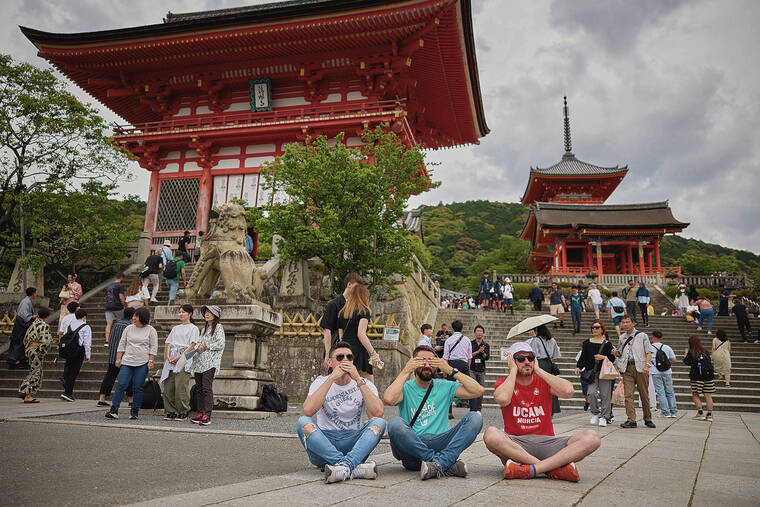KYOTO, Japan >>On two recent occasions, foreign tourists entered Matsumoto Shoji’s barbershop, asking for a haircut, through the front door, which creaks loudly when opened more than halfway.
One was Italian, the other British. Matsumoto, 75, didn’t speak either language and didn’t know what to say to them. He picked up a pair of scissors and began cutting, hoping his decades of experience would come in handy.
Since pandemic entry restrictions were eased in 2022, Japan has seen an influx of tourists, helped by a weak yen. Some government officials, including Prime Minister Fumio Kishida, have expressed concern about overtourism. In March, the number of international tourists topped 3 million, a new monthly record, and up more than 10% from March 2019.
About two-thirds of foreign tourists are from South Korea, Taiwan and China. Last year, spending by foreign tourists accounted for about 9 percent of Japan’s gross domestic product.
Popular tourist destinations in cities like Japan’s ancient royal capital, Kyoto, are becoming increasingly unmanageable, with tourists flocking to previously unseen areas, such as small towns near Mount Fuji and the Kyoto shopping district where Matsumoto runs her salon.
“Before, it was normal to have tourists in certain places,” Matsumoto says, “but now tourists are spread out in random and unexpected places.”
The influx is generally testing polite society’s patience.
In tourist-heavy cities such as Kyoto, residents complain that hotel rooms are too expensive, buses and restaurants are overcrowded and they can’t get in. They also say tourists are disrespecting local customs, such as chasing geisha to take photos or eating while walking, behaviour that is considered rude in Japan.
Last month, Hiroshi Saka took six hours, twice as long as usual, to visit Kyoto’s Heian Shrine. Mr Saka, 65, believes some of the delays were caused by tourists counting their fare coins and slowing down buses.
“Every day is like a carnival here,” Pan said. “We can’t enjoy our daily lives in peace.”
Even those who directly benefit from tourism worry that it will become unsustainable.
Kobayashi Hisashi, a taxi driver in Kyoto, said work was going so well that taking time off would feel like missing out on easy money, but he said many tourism-related industries were struggling to cope with pandemic-era labor shortages.
Some areas are feeling the strain for the first time, including Fuji City in Shizuoka Prefecture, about 200 miles east of Kyoto.
After the bridge offering a direct view of Mount Fuji became popular on social media last year, the Shizuoka City Tourism Bureau said on Instagram that it was a good place to take “beautiful, dreamy photos,” without mentioning that the bridge is in a residential area and has no parking, public toilets or trash cans.
Residents said many tourists were littering, parking in driveways and, in some cases, dodging traffic to take photos from the bridge’s median.
About 300 tourists came each day for four days over a national holiday last month, lining up along the path to take photos, said Mitsuo Kato, 86, who lives near the bridge.
“They just park here,” Kato said recently outside his home as a group of Korean tourists took photos of clouds obscuring Mount Fuji. “So we had to put up signs.”
Authorities across Japan have responded to the surge in tourists with varying degrees of effectiveness.
In Fuji city, authorities have built a temporary parking lot for six cars and have started construction on a larger one that can accommodate 15 cars and has toilets, said Motohiro Sano of the local tourism bureau.
In neighboring Yamanashi prefecture, authorities in the town of Fujikawaguchiko last month erected a billboard-sized screen to stop tourists taking photos of a Lawson convenience store with its blue awning at the base of Mount Fuji. Photos of the store have become a staple of social media posts. Local reports say the screen now has holes big enough to fit cell phone camera lenses.
Authorities in Tokyo’s tourist-heavy Shibuya district have announced plans to ban drinking outdoors at night in a bid to curb bad manners among young people and tourists.
On a recent weekend, some tourists visited Kyoto’s top spots at sunrise to avoid the crowds, or waited 40 minutes to eat at a popular ramen restaurant at 11 p.m. — and complained about the congestion they caused.
“This is a disaster,” said Paul Oosthveen, 70, a tourist from the Netherlands, as he left Kiyomizu-dera temple, a popular tourist attraction.
In his empty shop, Matsumoto said he successfully cut the hair of two foreign customers and that he would not turn away any other customers who just dropped by.
But he said he was concerned about providing good service to customers who don’t understand Japanese and would like non-Japanese speaking customers to go elsewhere.
Tourism is good for the country, but “there are some areas where we’re not completely satisfied,” he added.

